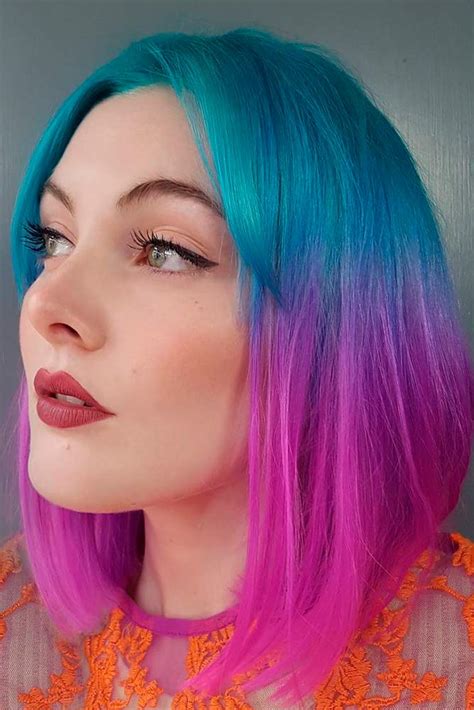The Duality of Hair Hues
Hair color plays a profound role in shaping our identity and self-expression. While a single shade can convey a distinct aesthetic, the combination of two hair colors creates a captivating allure that transcends the mundane. This alluring technique, known as two-tone hair or bicolor hair, has become a vibrant trend in the world of hair fashion.

Shades of Contrast: The Color Wheel’s Harmony
The art of two-tone hair lies in the harmonious blending of contrasting hues. Stylists leverage the color wheel as a guide, selecting colors that complement each other while creating a striking visual impact.
One popular approach involves juxtaposing complementary colors, such as red and green, blue and orange, or yellow and purple. These combinations provide a vibrant, eye-catching effect that demands attention.
Alternatively, analogous colors, such as green and blue, red and orange, or yellow and green, create a more subtle yet striking transition. They blend seamlessly, resulting in a sophisticated and cohesive look.
Techniques and Trends: Unleashing Artistic Freedom
Two-tone hair offers a wide range of techniques to cater to diverse preferences and hair textures.
- Balayage: A hand-painted method that creates soft, blended transitions between colors.
- Ombré: A gradual fading of one shade into another, creating a natural-looking effect.
- Dip-Dye: A bold approach involving dyeing the ends of the hair a contrasting color.
- Half-and-Half: A stark division of the hair into two distinct shades, creating a dramatic statement.
The Psychology of Perception: Impact on Emotions and Self-Confidence
Studies have shown that hair color can significantly influence our emotions and self-perception. Two-tone hair, with its inherent contrast and visual intrigue, has been found to boost confidence and enhance positive emotions.
The combination of complementary colors, for instance, is believed to evoke a sense of energy and excitement. Analogous colors, on the other hand, create a calming and soothing effect.
Practical Considerations: Maintenance and Versatility
While two-tone hair offers endless creative possibilities, it also requires careful consideration of maintenance and versatility.
- Maintenance: Bi-monthly touch-ups are essential to preserve the vibrancy and prevent roots from becoming apparent.
- Versatility: Two-tone hair can be adapted to suit various hairstyles and facial features. Experimenting with different partings, braids, and updos can create diverse looks.
Generating Variations: Ideas Beyond the Color Wheel
The combination of two hair colors opens up endless possibilities for creating unique and captivating looks. Here are some ideas to inspire your creativity:
| Contrast Type | Examples |
|---|---|
| Complementary | Red and green, blue and orange, yellow and purple |
| Analogous | Green and blue, red and orange, yellow and green |
| Neutral | Black and blonde, brown and ash, silver and gold |
| Pastel | Pink and lavender, blue and mint, yellow and peach |
| Metallic | Copper and gold, silver and platinum, blue and rose gold |
Table 1: Tips and Tricks for Achieving Two-Tone Hair Perfection
| Tip | Description |
|---|---|
| Choose complementary or analogous colors that harmonize well. | Create a striking yet cohesive look. |
| Consider your skin tone and facial features when selecting shades. | Enhance your natural beauty. |
| Start gradually with subtle transitions. | Experiment with different techniques to find the perfect balance. |
| Invest in professional hair care products. | Protect and maintain the vibrancy of your colored hair. |
| Schedule regular touch-ups. | Preserve the desired effect and prevent roots from becoming visible. |
Table 2: Common Techniques for Two-Tone Hair
| Technique | Description |
|---|---|
| Balayage | Hand-painted transition between colors for a soft, blended look. |
| Ombré | Gradual fade from one shade to another for a natural effect. |
| Dip-Dye | Dyeing the ends of the hair a contrasting color for a bold statement. |
| Half-and-Half | Stark division of the hair into two distinct shades for a dramatic look. |
Table 3: Hair Textures and Compatibility with Two-Tone Styles
| Hair Texture | Compatibility | Considerations |
|---|---|---|
| Fine | Balayage, ombré | Avoid dip-dye and half-and-half techniques that can weigh down hair. |
| Medium | All techniques | Experiment with different styles to find the most flattering option. |
| Thick | Dip-dye, half-and-half | Avoid balayage and ombré techniques that may get lost in the volume. |
| Curly | Balayage, ombré | Diffuse hair to enhance the color transitions. |
Table 4: Styles and Hairstyles for Two-Tone Hair
| Hairstyle | Description |
|---|---|
| Braids | Incorporate two contrasting hair colors into braids for a playful and eye-catching look. |
| Updos | Create elegant updos with contrasting hair colors to highlight different sections of the hair. |
| Pixie Cut | Experiment with two-tone hair on a pixie cut for a bold and edgy style. |
| Long Layers | Add dimension to long layers with different hair colors, creating a cascade of hues. |
| Bob Cut | Pair a bob cut with contrasting hair colors for a chic and modern look. |
Embracing the Symphony of Contrasts
Two-tone hair is a canvas for artistic expression, allowing individuals to showcase their unique personality and style. By embracing the duality of hair hues, this captivating technique creates an alluring visual symphony that captivates the senses. Whether you seek a bold statement or a subtle touch of contrast, the versatility of two-tone hair empowers you to define your own hair story.
